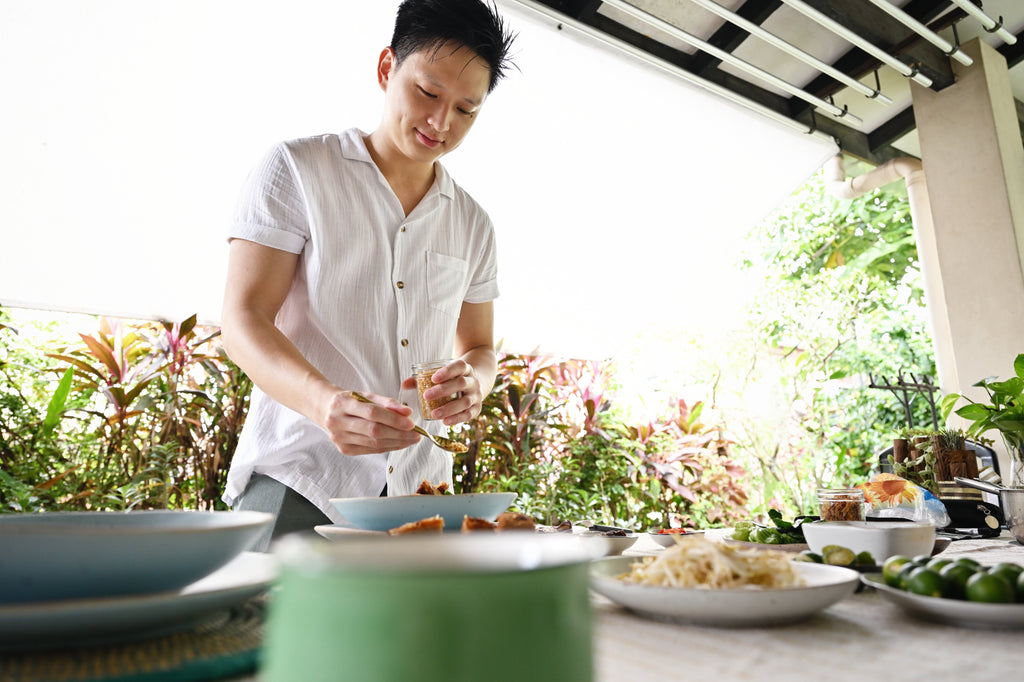From nose-to-tail dining to crow-infused moonshine, Ryan Foo’s food adventures are a wild dance across continents and comfort zones. When asked "what don’t you eat?", the private chef and food stylist declares with a smile, “I eat everything.” As we soon learn, no ingredient is too pungent or too “out there” for Ryan’s insatiable appetite for culinary discovery.
Born to a Filipino-Spanish mum and Malaysian-Chinese dad, Ryan’s taste buds were seasoned from a young age. Library trips with his mum weren’t for books, but for cookbooks which he would leaf through for recipes to try.
My parents exposed us to a wide variety of culture and food from all over the world, especially when we visit their hometowns. So the food I enjoyed in my childhood was pretty diverse. We had Indian food like dosai, poori or Thai food on my dad’s off days. My mum would also cook Chinese or Filipino food a lot.
But my first foray into the world of cooking would be when I accompanied my mum to the library. She liked borrowing cookbooks and trying out recipes, so the first dish I made came from a book that I found interesting. Strangely enough, it was crème brûlée.
We first met Ryan at The Gifting Edition 2023 of Boutique Fairs, where he was a fellow vendor showcasing his artisanal butter brand, Meraki Butters. The story behind his brand is simple: to encourage people to easily elevate simple dishes with bolder flavours using their collection of Asian-inspired compound butters.
 Featuring Ryan’s Sze Chuan Mala Butter, one of the three signature flavours available at Meraki Butters. Watch as he drizzles spoonfuls of this tangy and fragrant delight, adding the finishing touch to his dish.
Featuring Ryan’s Sze Chuan Mala Butter, one of the three signature flavours available at Meraki Butters. Watch as he drizzles spoonfuls of this tangy and fragrant delight, adding the finishing touch to his dish.
Three months later, we had the pleasure of enjoying a sit-down lunch cooked and plated by him, featuring his rendition of kare kare, a traditional Filipino dish close to his heart. Below, Ryan tells us more about his culinary adventures and his transition from working as a chef at a fine dining restaurant to the multi-faceted food personality that he is today.

 On the menu: Kare kare. While this dish is traditionally cooked with innards and tendons, Ryan brings his own twist by incorporating garlic-roasted pork belly and a colourful mix of vegetables.
On the menu: Kare kare. While this dish is traditionally cooked with innards and tendons, Ryan brings his own twist by incorporating garlic-roasted pork belly and a colourful mix of vegetables.
Working in a professional kitchen helped refine my skills and techniques as a chef, but I didn’t quite like the environment and lifestyle. It felt like a continuous cycle of opening and closing my eyes, and BAM! I’m back in my chef whites, slammed with another 14-hour shift in the kitchen. It was hard to have the mental capacity for anything else.
I love interacting with guests, forming connections through the sharing of food, experience, and culture, which is hard to do in a restaurant kitchen setting. So I began [my private chef journey] to make more casual dishes that evoke a sense of fullness and establish a deeper connection — both for the stomach and heart.
 With a styling tweezer in hand, Ryan strategically plans the plating order for his kare kare dish. His key tip for achieving a restaurant-worthy presentation? Vary the height and avoid having tall items positioned towards the viewer's eye.
With a styling tweezer in hand, Ryan strategically plans the plating order for his kare kare dish. His key tip for achieving a restaurant-worthy presentation? Vary the height and avoid having tall items positioned towards the viewer's eye.
I feel that there are a lot of cultural aspects and stories behind a dish that can get lost when a dish is made to be too pretty. So with my private dining experiences, I aim for a balance, keeping the dish refined and presentable but not to the point of it being too deconstructed. And with private dining, I also get to keep things casual and engage in banter with my guests.
On top of offering butters, Ryan also develops recipes to inspire creative ways to cook with Meraki Butters. Explore their Butter Bible for more culinary inspiration.
Though I enjoy doing R&D and exploring possibilities on my own, cooking for others brings me much more enjoyment. There are a lot of safe eaters who don’t know where to begin when it comes to trying new types of food and cuisine, so I’d like to share the food I’ve eaten during my travels, as well as the food from my heritage.
The real enjoyment for me comes from expanding someone’s culinary horizons, allowing them to determine whether they like it or not, and hopefully providing them a soul satisfying experience, like the feeling you get when a dish “hits the spot” or when you’re trying something new for the first time, and really like the flavour.
I always say to try things twice before deciding if you really dislike it.
 Ryan’s tip for those looking to be more experimental and adventurous in their cooking and eating: pick an ingredient you’re not averse to trying and cook it with things you enjoy. Case in point is this beansprout salad doused in sambal matah. Our team member had seconds despite not liking beansprouts — proof that embracing new flavours can lead to delightful surprises!
Ryan’s tip for those looking to be more experimental and adventurous in their cooking and eating: pick an ingredient you’re not averse to trying and cook it with things you enjoy. Case in point is this beansprout salad doused in sambal matah. Our team member had seconds despite not liking beansprouts — proof that embracing new flavours can lead to delightful surprises!
I feel that Singaporeans don’t realise the value and uniqueness of our mish-mash cuisine as it’s too integrated in their daily lives.
It’s pretty hard to recreate the flavours of local cuisine. You can have a Michelin star in a restaurant or a hawker, but everyone will always have a strong, opinionated view on what makes the best chicken rice, hokkien mee, carrot cake, and so on.
But hawker dishes possess nuanced flavours that have been honed over years of repetition, and we are blessed to have multiple amazing refined dishes that are affordable, and just a short 5-min walk away. Hawker culture is just magnificent, and it’s really hard to replicate. I respect hawkers a lot for it and they deserve more credit in the culinary scene.
 A big thank you to Ryan for hosting us, treating us to hometown flavours, and sharing his culinary knowledge with us.
A big thank you to Ryan for hosting us, treating us to hometown flavours, and sharing his culinary knowledge with us.

Featured products
 Sii Faa Free-Form Pasta Bowl
Sii Faa Free-Form Pasta Bowl
 Sii Chompuu Free-Form Side Plate
Sii Chompuu Free-Form Side Plate
 Bamboo Cutlery in Polished Gold
Bamboo Cutlery in Polished Gold
 Talay Square Snack Bowl
Talay Square Snack Bowl
 Dusit 21cm Round Side Plate (extended collection)
Dusit 21cm Round Side Plate (extended collection)

